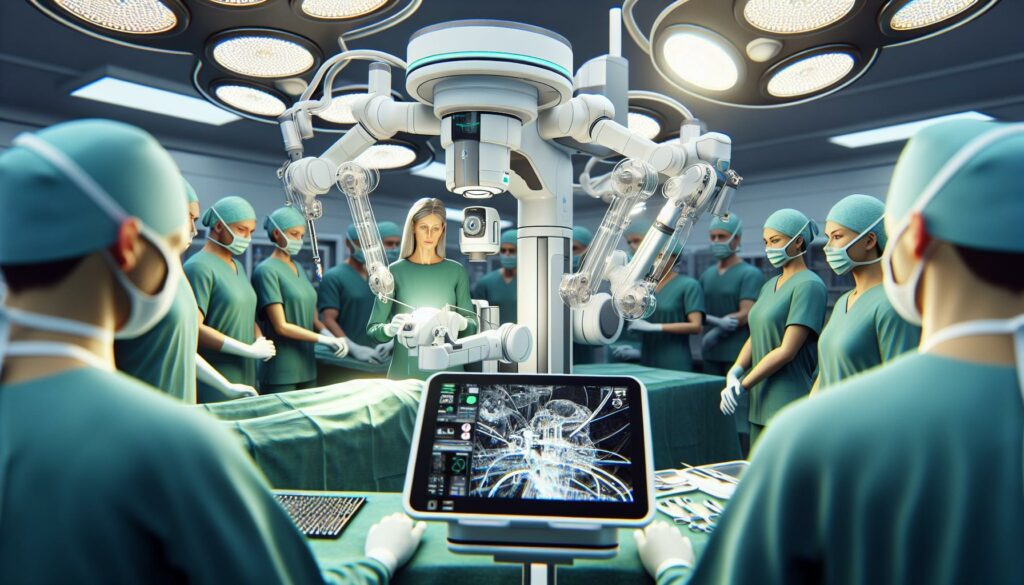Mako Robotics is revolutionizing the landscape of surgical procedures with its cutting-edge technology. As I delve into the world of robotic-assisted surgery, I can’t help but be fascinated by how Mako’s precision and innovation are transforming patient care. This advanced system not only enhances surgical accuracy but also minimizes recovery time, making it a game-changer for both surgeons and patients alike. In this article, I’ll explore the incredible capabilities of Mako Robotics and its impact on various medical fields. From orthopedics to other specialties, the integration of robotics in surgery is paving the way for a new era of healthcare. Join me as I uncover the remarkable features and benefits that make Mako Robotics a leader in surgical innovation.
- Revolutionizing Surgical Procedures: Mako Robotics employs advanced robotic-assisted technology to enhance surgical accuracy and patient care, fundamentally changing the landscape of surgery.
- Precision and Customization: Utilizing 3D modeling, Mako allows for personalized surgical plans that improve outcomes, especially in orthopedic procedures like knee and hip replacements.
- Minimized Recovery Times: The minimally invasive techniques enabled by Mako result in less soft tissue damage, lowering recovery times and increasing patient satisfaction.
- Integration with Healthcare Systems: Mako Robotics seamlessly integrates into existing surgical workflows, improving operational efficiencies and reducing the risk of surgical complications.
- Cost and Training Challenges: While offering numerous benefits, the adoption of Mako Robotics also presents challenges such as high initial costs and the need for extensive training for surgical teams.
- Enhancing Patient Care: The technological advancements offered by Mako lead to improved patient outcomes, including shorter hospital stays and quicker rehabilitation.
Mako Robotics
Mako Robotics specializes in robotic-assisted surgical technology, transforming surgical procedures. Mako’s platform enhances surgical precision, offering a unique combination of advanced imaging and sophisticated instrumentation. Using 3D modeling, Mako creates personalized surgical plans, ensuring better outcomes for patients.
Mako’s applications extend primarily to orthopedic surgeries such as knee and hip replacements. Surgeons can access varying degrees of joint information, enabling them to perform minimally invasive procedures, significantly reducing recovery times. Mako’s technology incorporates real-time feedback, allowing for adjustments during operations, ensuring optimal performance.
Mako Robotics is notable for its impact across multiple medical fields. The system’s ability to integrate seamlessly with existing surgical workflows makes it a valuable tool for healthcare providers. With continued advancements in robotic technologies, Mako prepares to redefine surgical standards and enhance patient safety and satisfaction.
Features of Mako Robotics
Mako Robotics boasts several compelling features that contribute to enhanced surgical outcomes. Key attributes include advanced technology and unmatched precision.
Advanced Technology
Mako Robotics employs cutting-edge imaging technology and robotics to transform surgical procedures. The platform utilizes advanced 3D modeling, which allows surgeons to create customized anatomical plans tailored to each patient. This technology also combines real-time imaging with navigational assistance, offering clear visual cues for improved decision-making during surgery. The robust software ensures that the robotic arm operates within precise parameters, minimizing variability and enhancing consistency across procedures.
Precision and Accuracy
Mako Robotics offers exceptional precision and accuracy during surgical interventions. The system’s design mitigates human error and enhances the surgeon’s ability to target specific anatomical structures accurately. For example, in orthopedic surgeries such as knee and hip replacements, the robotic assistant provides real-time feedback, allowing for micro-level adjustments. This capability results in better implant placement and alignment, ultimately leading to higher levels of patient satisfaction and faster recovery times. By ensuring that surgical procedures are executed with unparalleled accuracy, Mako Robotics sets a new standard in the surgical field.
Applications of Mako Robotics
Mako Robotics plays a pivotal role in enhancing surgical practices across several medical fields. Its advanced technology and precise instrumentation significantly impact both the healthcare industry and surgical procedures.
Healthcare Industry
Mako Robotics primarily supports the healthcare industry by improving surgical outcomes and operational efficiencies. By integrating advanced imaging technology, Mako streamlines the surgical workflow in hospitals and surgical centers. Hospitals using Mako systems report increased patient throughput due to shorter operation times and quicker recovery periods. Additionally, Mako efficiently reduces the risk of surgical complications, leading to decreased lengths of hospital stays. As a result, healthcare providers can offer safer and more effective treatment options, ultimately enhancing overall patient care and satisfaction.
Surgical Procedures
Mako Robotics specializes in robotic-assisted surgical procedures, particularly within orthopedics. The system utilizes 3D modeling to assess each patient’s unique anatomy, allowing for tailored surgical plans that optimize outcomes. In knee and hip replacements, for instance, Mako enables minimally invasive approaches, reducing soft tissue damage and subsequent recovery times. The technology provides real-time feedback during surgery, ensuring precision in implant placement and alignment. Surgeons benefit from improved accuracy, resulting in better functional outcomes for patients. Mako’s advanced capabilities redefine surgical standards, enhancing both the effectiveness of procedures and patient experiences.
Benefits of Mako Robotics
Mako Robotics offers numerous advantages that significantly impact both surgical procedures and patient care. These benefits encompass improved patient outcomes and enhanced operational efficiency.
Improved Patient Outcomes
Mako Robotics enhances patient outcomes through its precision-driven approach. The system’s 3D modeling capabilities allow for personalized surgical plans tailored to each patient’s unique anatomy. This customization improves implant placement accuracy, leading to fewer complications and better recovery trajectories. Studies show that patients experience reduced hospital stays and quicker rehabilitation timelines when treated with Mako technology. Furthermore, the minimally invasive techniques employed by Mako not only lessen surgical trauma but also contribute to increased patient satisfaction due to diminished pain and faster return to normal activities.
Efficiency in Operations
Mako Robotics streamlines surgical workflows, leading to enhanced efficiency in operations. The integration of advanced imaging and real-time feedback systems facilitates quicker decision-making during procedures. This technology allows surgical teams to optimize their processes, resulting in shorter surgery times and increased patient throughput. By decreasing operational delays, Mako promotes more effective use of surgical resources, which can lower costs for healthcare facilities. Additionally, its ability to seamlessly mesh with existing surgical protocols ensures that healthcare providers can adopt Mako without significant disruptions to their operations.
Challenges and Considerations
Mako Robotics presents several challenges and considerations that healthcare providers must address to fully leverage its benefits. These challenges primarily revolve around cost, accessibility, training, and implementation.
Cost and Accessibility
Costs associated with Mako Robotics can be significant. Initial investment in the robotic systems often requires substantial financial resources, which may limit accessibility for smaller healthcare facilities. Ongoing maintenance, consumable supplies, and necessary upgrades contribute to total ownership costs. Facilities must evaluate cost-benefit scenarios to determine long-term viability. Additionally, discrepancies in healthcare funding across regions can affect availability, with urban centers typically having more access to advanced technology than rural hospitals.
Training and Implementation
Training and implementation present additional challenges. Ensuring that surgical teams gain proficiency with Mako’s technology involves a time-consuming process. Comprehensive training programs must be conducted to allow teams to utilize the system effectively. Additionally, integrating Mako into existing workflows requires careful planning. Operating room staff must adapt to new protocols and incorporate robotic assistance seamlessly to maximize efficiency. Continuous support and advanced training are essential to maintain high standards of surgical excellence and optimize patient outcomes.
Mako Robotics is truly reshaping the landscape of surgical procedures. Its advanced technology not only enhances precision but also significantly improves patient outcomes. I’ve seen firsthand how its capabilities in orthopedics lead to faster recovery times and greater patient satisfaction.
As healthcare continues to evolve, Mako stands out as a crucial player in driving innovation. While challenges remain in terms of accessibility and training, the long-term benefits for both surgeons and patients are undeniable. Embracing this technology could very well set new standards in surgical excellence. I’m excited to see how Mako Robotics will continue to impact the future of healthcare.

